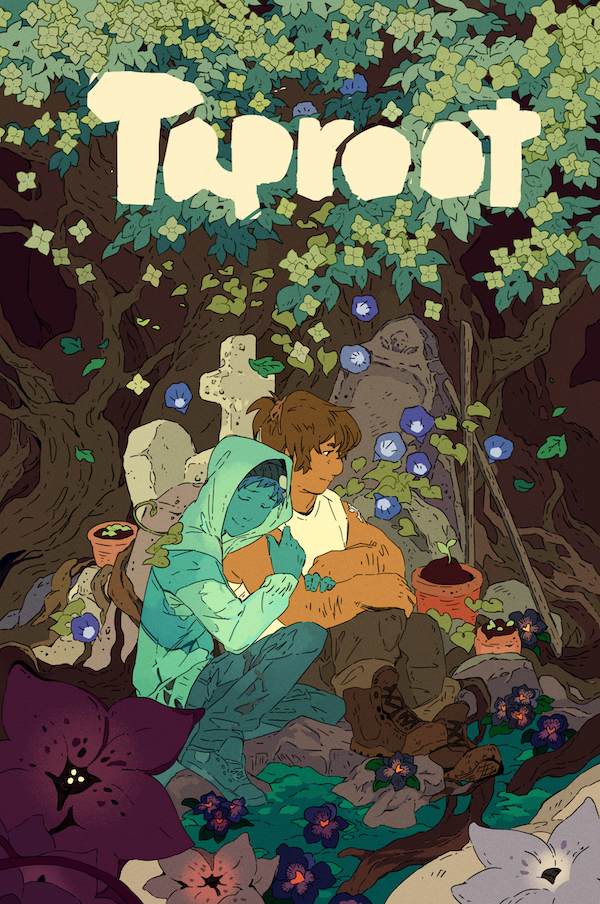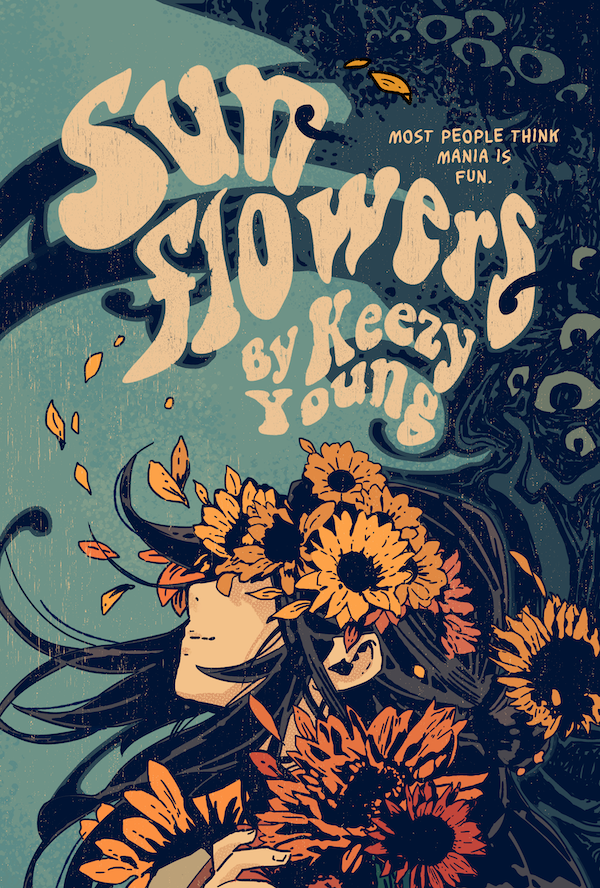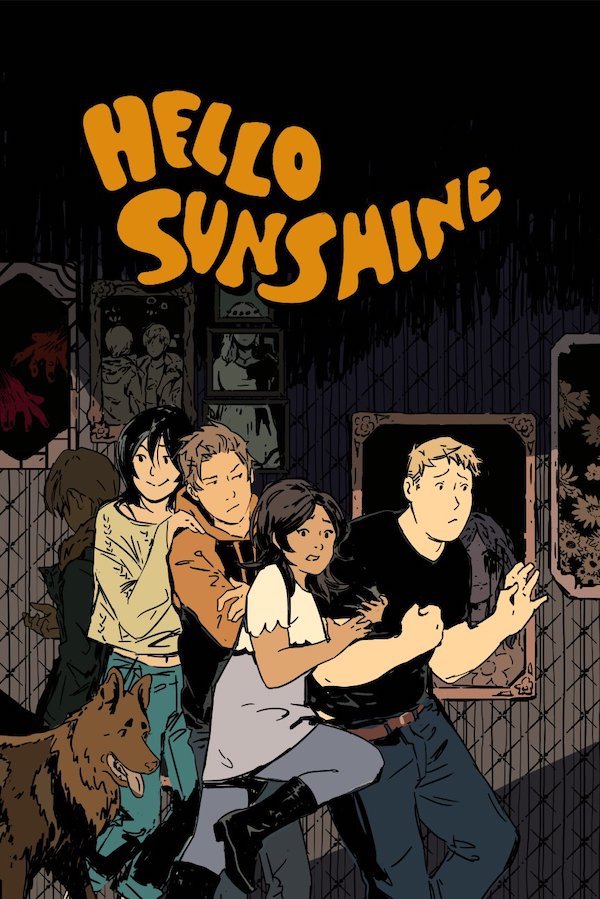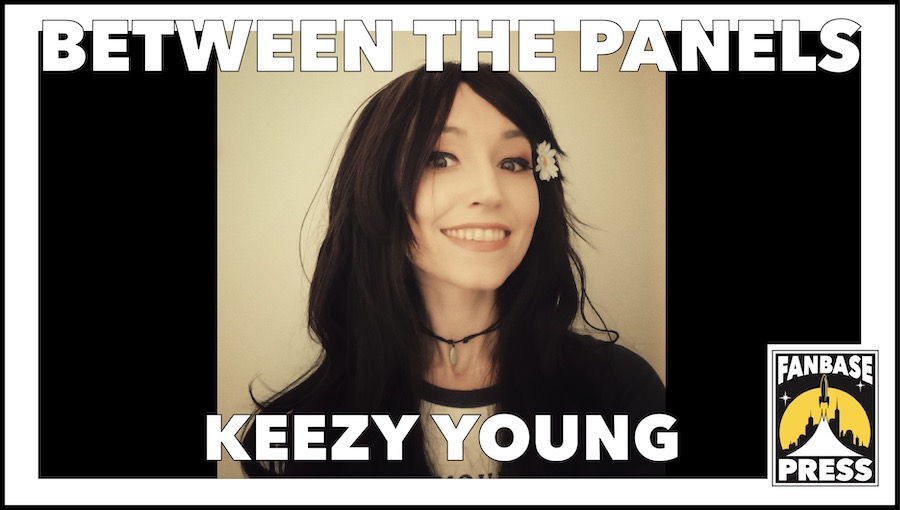“Between the Panels” is a monthly interview series focusing on comic book creators of all experience levels, seeking to examine not just what each individual creates, but how they go about creating it.
It might seem like a child growing up in a forest setting, nourished by an abundance of different creative media, would be destined to end up in the arts somehow. Still, Keezy Young had a long, challenging path to navigate in order to manifest dreams into reality — and that success has made the comics world a richer place.
First off, the basics…
Your specialties (artist/writer/letterer/inker/etc.): Cartoonist
Your home base: Seattle, WA
Website: keezyyoung.com
Social Media
Instagram: @keezyyoung
Twitter: @KeezyBees
Bluesky: @keezyyoung
Tumblr: @keezybees
Fanbase Press Contributor Kevin Sharp: I start with the same big question for everyone: Why comics? What is it about this medium that appeals to you as a creator?
Keezy Young: I always had a story to go with everything I drew. Whether it was a recurring character or a series of sequential illustrations, I could tell you everything about what was going on in my art, who these characters were, and what their motivations were. I think comics was an inevitable end point for that kind of passion for both stories and art, and particularly stories told through art.
KS: Please tell readers about where you grew up and what your creative diet looked like as far as things you enjoyed consuming as a kid — books, movies, TV, music, etc.
KY: I grew up in the forest, on an unincorporated dirt road in the middle of nowhere, outside the city limits of two small rural towns. I read a lot of comics, read a lot of Animorphs and Goosebumps, and I watched a lot of TV — some favorites were the animated X-Men, Bewitched, X-Files, Tales from the Crypt, Digimon, and Gargoyles. But I also played a lot of video games, because my dad was, and is, a huge gamer. I started out watching him play, along with my younger twin siblings, and once I was old enough he taught me how to play myself. We were probably a little young for Diablo and DOOM, but it was a great time, haha.
The other huge part of my creative diet, though, was music. I have always loved music. I was listening to the Mamas and the Papas, Nirvana, the Cranberries, Fleetwood Mac, Dusty Springfield, and the Ramones by the time I was 7. I would steal my parents’ CDs and record stuff off the radio onto tapes. To this day, I think music is the number one thing that inspires me to make my own creative work.

KS: Were your parents also big music fans?
KY: My dad is a huge music nerd, yes! We’re always playing ‘Name That Tune’ to see if we can figure out the song in the first 1-3 seconds. He and my mom go to more shows now than I did when I was in my 20s. My mom, meanwhile, is more of a bookworm. She has her own library in the attic, and she’s always reading something. I’ve been getting her more into comics now, but she’ll read anything, and we have great discussions about books we’ve both read.
KS: Did they have interests in other creative arts you were aware of while growing up?
KY: I wouldn’t say any of my extended family are artists the way I am, but they’re certainly creative in different ways. My mom with gardening, for example, my nana with knitting, my brother with D&D. We all have lots of different and overlapping interests, from movies and video games, to comics and novels, to gardening and music. Even if my family members don’t engage in creating the stuff they love the way I do, they still love it with a passion, and we all bond over it.
KS: Do you recall when you first discovered comics? Would it have been through traditional floppies, newspaper strips, webcomics, or…?
KY: I think the first comic I ever read was probably Calvin and Hobbes, because we had a huge omnibus of it! We didn’t have a comic shop in my hometown, but I would always make a beeline for the comics section of any bookstore we visited, so I also read stuff like Spider-Man, X-Men, Runaways, Young Avengers, etc., albeit spottily. In middle school I discovered manga via Naruto and Fullmetal Alchemist. So, I guess I would say I’ve been reading comics from the beginning, but it was a little bit of everything — basically whatever I could get my hands on!
KS: If you had to read spottily in the beginning, at what point did you have easy access to the medium, as in being able to read/buy on a regular basis?
KY: I didn’t truly get easy access to comics until I started absolutely devouring manga fan translations online in high school, and then later when I moved to Seattle, I was able to check comics and graphic novels out at the library. I’d long since exhausted my small town library’s collection. I admit I also spent quite a bit of time in my youth hiding in the stacks at bookstores, reading the latest trades for all my favorite series before putting them back on the shelves. Now, I pay for access to Marvel Unlimited for my superhero fix, and buy plenty of books for my own shelves, but I still utilize the library quite a lot!
KS: Can you share a comic story that had a real impact on you as a younger reader?
KY: I think the comic that probably had the most impact on me when I was young was Fullmetal Alchemist. It’s a great story, it’s gorgeously drawn and filled with drama and tragedy and hilarity, but most importantly for me at the time was when I realized it was drawn by a woman. Hiromu Arakawa depicts herself as a cartoon cow, so it took me a while to figure it out, but when I did, it was like a light went off in my head — men aren’t the only ones who are allowed to make comics.

KS: Was that last idea something you’d faced before?
KY: It sounds ridiculous now, but, honestly, it had never occurred to me that comics were something I could make as well as read. All of the comics I’d read to that point were made by men, aside from Cathy in the newspapers — which I hated! Sorry, Cathy Guisewhite, it just wasn’t for me.
I always felt like an invader in the spaces I loved, whether it was video games, horror, D&D, superheroes, or music. None of the guys would treat me like one of them; I was always a novelty, or lying, or a potential cool girlfriend instead of just a friend with similar interests. I’d tried my hand at being a musician — I was in two indie rock bands in high school, playing both guitar and cello — but I was never accepted by the men around me. I was objectified and dismissed, and I eventually decided that that world wasn’t for me, even though I loved making music.
So, when I realized that I could make a comic all on my own, play all the parts in the band, so to speak, just like Hiromu Arawaka, I knew I didn’t have to gain the support or respect or even presence of other people to create something I loved — I could just do it, because it was fun, and because I felt like it. I tried my hand at my own comic shortly afterward — it was an un-subtle Naruto knockoff, lost to the ages now, probably for the best — and realized how much I loved it. Nobody ever even read it, I just had a great time coming up with the story and characters and drawing pages. It took me another almost-decade to figure out that this was what I wanted to do for a living, but yeah; reading Fullmetal Alchemist was the start of me becoming who I am today.
KS: Speaking of making your own art, do you recall approximately when that transformed from hobby to something you took more seriously?
KY: Honestly, even though I was always serious about it in terms of my passion for it, I had always thought of art as a hobby. I went to school for international relations, believe it or not, and I always thought I would end up as some kind of teacher or in a diplomatic position. I just always assumed that art wasn’t a viable career! But when I did [the graphic novel] Taproot when I was around 25, I realized that it was the one thing that made me more happy than anything else; and when I was laid off from my day job soon afterward, I decided to make a go of freelance, just to see if I could do it. Now, I can’t see myself doing anything else, but yeah, the journey to get from hobbyist to serious artist was a long one!
KS: What was that freelancing period like for you?
KY: I sort of fell into doing it as a living because of circumstances outside of myself; both losing my day job, and my mental health taking a turn for the worse in my mid-20s — I have bipolar 1 disorder, which comes with occasional severe manic psychotic episodes, as well as periodic long episodes of severe depression. I wasn’t able to work full time in a normal job while I was so unstable, so art became the only real way for me to make money. But it was also the thing that gave me the most happiness, and when I was stable, I was so fulfilled and so enthusiastic about my work, it became obvious that this was where I was meant to be. Really truly getting to a good place with it meant getting my illness under control, but now that I’m here, there’s nowhere I’d rather be.
KS: Was there family support for the idea of pursuing art “for real”?
KY: I think my parents worry about me a lot, both because of my mental illness, and because I’m a cartoonist for a living, haha. I know they want me to be stable, healthy, happy, and safe, and I think they’d be fine with whatever I choose to do as long as it gets me those things. The problem with cartooning, of course, is that it’s not a particularly lucrative career, so they do have concerns about that. But although they might wish I had chosen a more financially stable career, they are supportive, nonetheless, and I know they’re proud of me.
KS: Did you have any role models — who you knew personally or admired from afar — who gave you a framework for what kind of career you’d like to aim for?
KY: All of my colleagues in comics have given me inspiration and motivation! But I try not to model my work or my goals off of any specific person — it has been way more beneficial for me to try different things and figure out what works for me, specifically. I tried webcomics, for example, and realized that that mode of working just didn’t work for me. I tried working on other people’s scripts, and didn’t enjoy that, either. There’s nothing wrong with those things, they just weren’t what I needed to be doing. Where I belong is writing and drawing my own comics, both shortform and in graphic novel format; it took me a while to figure it out, but now I’m pretty satisfied with my career, both in terms of where it’s at now, and its trajectory!
KS: What was the first time you ever got paid for a piece of art?
KY: I think it was when I was still in high school. I sold a watercolor painting to a friend, who hung it in his room when I was maybe 15 or 16. I started taking commissions when I was 18, and did that periodically up through my mid-20s, when I started doing comics and conventions instead. I prefer working on my own projects as opposed to other people’s ideas, it turns out!
KS: Let’s jump into Taproot. As far as the genesis of that project, which came first: story or images?
KY: Definitely images! I always start a project with the aesthetic first, and for Taproot it was ghosts plus flowers. From there I designed Blue to represent the ghosts, and Hamal to represent the flowers, and the story started developing with the characters! As for its genesis, I would say it was probably some combination of having grown up watching and helping my mom in her garden, wanting to give my child self a queer story that would’ve helped me feel less hopeless, and having lost a lot of people fairly young. I liked the idea that there might be someone who could help lost spirits find their way.

KS: When it came time for it to “leave the nest,” did you have to learn how pitch to publishers? Please talk us through your experience in that area.
KY: For Taproot I just sat down and decided I wanted to make a book, because I was bored after my day job. I did it, and then posted online and printed a few copies to bring to NYCC with me; that’s where I met my editor, and later got the offer to publish. It all went pretty smoothly from there!
With Hello Sunshine, my new graphic novel, it was a completely different process. I came up with the idea, then ran it past my agent to see what she thought, then started work on a summary, outline, character descriptions, and sample pages. Once that was all ready to go, I sent it to my agent, who sent it to Little, Brown and Company; they held a pitch meeting to see if they wanted to pick up the project, and then made me an offer for an advance. I accepted, then got to work on the script, which went through a few rounds of edits. Once the script was approved, I started on thumbnails, pencils, inks, colors, and letters. Basically, each phase has to be approved before moving onto the next phase!
Once I’m finished with the book, I’ll turn in my pages, receive final copyedits and such, and then it goes into production for the next year or so before it actually comes out, which gives us time to come up with a good cover design, marketing material, and other nuances of production — like checking proofs for printing errors and such. So overall, the ‘official’ publishing process is a lot more in-depth and complex than what I did for Taproot. Some publishers have shorter timelines or less editing support, some have longer timelines and more intense editing.
KS: Any general guidance for up and coming creators who may be facing this process?
KY: Who you go with depends partly on the advance offered, but also the conditions with which you’d like to work. Some good questions to ask are ‘how many rounds of edits should I expect?’, ‘how much creative freedom do I have to put my foot down on edits I don’t like?’ and ‘what do the editing and book production timelines look like?’
KS: When you look back on that time now, what’s something you learned — about making comics, about the business, about yourself as an artist — along the way from when you first started working on the book?
KY: Oh, I’ve learned so much since I started Taproot, I’m not even sure I could quantify it in a single answer. That was almost a decade ago, when I still had a day job, didn’t really consider myself a cartoonist per se, and never realized how important comics would become to me. I’ve changed a lot since then both as a person, and as an artist and writer. I never expected anybody to really read Taproot! It was just an after-work passion project that I spent about 4 months on, total. The response it’s gotten, to this day, just blows me away.
But I also definitely see all the places where it could be improved, and I’m excited to share my next book so that my readers can see how much I’ve progressed as a cartoonist. I think I’ve really honed in on what I want to say with my work, and how I want to say it, as well as of course improving in my artistic skill and all that.
KS: Can you share what that was you honed in on during your journey?
KY: Part of that journey had to do with a scary diagnosis and recognizing that stories about people with severe mental illness are as important to me as stories about queer people — among others, of course. SMI [Severe Mental Illness, usually involving psychosis] is something a lot of people don’t really understand, even if they struggle with mental illness themselves. I am driven to write stories where I can explore my own experiences, but also improve understanding and compassion in others, as well as help others like me feel less alone in their struggle. And I want to do it in a way that’s fun and exciting and wonderful, because so often when we do appear in stories, it’s either in terms of a terrifying villain, or it’s just mundanely tragic and depressing. There is a world where we can exist in any genre, as any type of character, and I mean to help us get there.
KS: Hypothetical time: You can spend one day in the studio of any artist from comics history, sharpening pencils, getting coffee, picking their brain, etc. Who’s your pick and what would you hope to get from that day?
KY: Ooh, this is such a tough one! I’m going to cheat, because I’m perfectly torn between four answers: Jack Kirby, because he’s our godfather, and he seemed like a pretty interesting guy, and of course he’s not with us anymore, so I wouldn’t get any other opportunities to meet him. Mike Mignola, because I adore his work, and I would be happy just to watch him draw for hours on end. David Aja, because I’ve been told my current work resembles his, and I’m curious about his process and how it compares with mine! And finally, E.M. Carroll, author of A Guest in the House and Through the Woods, because their horror comics are so inspiring to me, and I would love to talk to them about how they come up with their ideas.
KS: Please shout-out any person who’s been especially helpful in your comics career. Could be someone who opened a door for you, gave you good advice, made an introduction, etc…
KY: I would love to mention a couple of people. One, my editor, Andrea Colvin, who I worked with both on Taproot and am currently working with on Hello Sunshine. I would not be where I am today had she not taken a chance on my book at NYCC all those years ago, and she’s been immeasurably helpful in making HS the book it needs to be.
Second, my best friend, Scout, who has been with me every step of the way, through the fun stuff and the harder stuff. We work together every day remotely, and share our work with each other, and he’s always the first person I show something new to. He’s not my official editor, but he’s been just as instrumental in making HS what it is today. He’s always there to shore up my confidence when I need it, offer critiques when I need that, and talk through struggles I’m having, both creatively and personally. I have no idea where I would be without him, honestly.
KS: Imagine a Comic Book Hall of Fame and you get to induct any title as an example of the medium at its very best. What gets your plaque?
KY: This is almost impossible, there are so many amazing works out there, and what I love about them is how different they all are! Some titles running through my head are Laura Dean Keeps Breaking Up With Me by Rosemary Valero-O’Connell and Mariko Tamaki; Paper Girls by Brian K. Vaughan and Cliff Chiang; Matt Fraction and David Aja’s Hawkeye; Hellboy by Mike Mignola; The Vision by Tom King; and A Guest in the House by E.M. Carroll. This is just the tip of an iceberg, though, and there are so many things I love about other stories, too, things that are unique and incredible, things that inspire me.
KS: All great titles, but totally more cheating! What if you had to narrow it to one?
KY: I’m going to go out on a self-serving limb instead and nominate my own book, Hello Sunshine, because I sort of think of it as a vessel for all of that inspiration. It’s a book that could not have been made without the stories that came before, the stories that continue to be written as I make it, and I like to think I’ve taken all of my favorite things from those stories and weaved them into my own work. I’ve poured so much love for the medium into this comic; I wake up every day excited to get to it, loving what I do, and loving my story and the act of making it, and so for me, HS is, at the moment certainly, the most meaningful comic out there. Whether or not it’s the medium at its best, it’s certainly me at my best. I can only hope that others feel the same way about it as I do, at least to some extent!
I don’t think I’d ever be brave enough to actually put my name in for something like this in real life, but it’s something to aspire to!

KS: Finally, please let readers know about Hello Sunshine, Sunflowers, and anything else you have out.
KY: The biggest thing I’m working on is Hello Sunshine! It’s my new graphic novel, coming out with Little, Brown and Co. in fall of 2025. It’s a YA mystery graphic novel with horror elements; it’s about a missing teenager named Alex. Noah comes home from bible camp to find that his secret boyfriend, Alex, has disappeared after some kind of traumatic breakdown, and as Alex’s friends and family start experiencing strange, terrifying occurrences, they start to wonder if perhaps Alex didn’t run away, after all. The book has themes of family (both found and blood), mental illness, grief, and different kinds of love. I’m extremely excited about it, and I can’t wait to share it with everybody!
I’m also always working on a few short comics, and the latest one is called Sunflowers. It came out in March of 2024 with Silver Sprocket, and it’s a 24-page autobio comic about my experience with bipolar disorder, both what it’s like to go through episodes, and the stigma around the illness. You can read it for free on Silver Sprocket’s website. Or pick up a physical copy either online, or at your local comic or bookshop!
(Side note: The physical edition is extraordinarily gorgeous. Silver Sprocket does an amazing job with their printing, and I’m so lucky that I got to work with them!)

